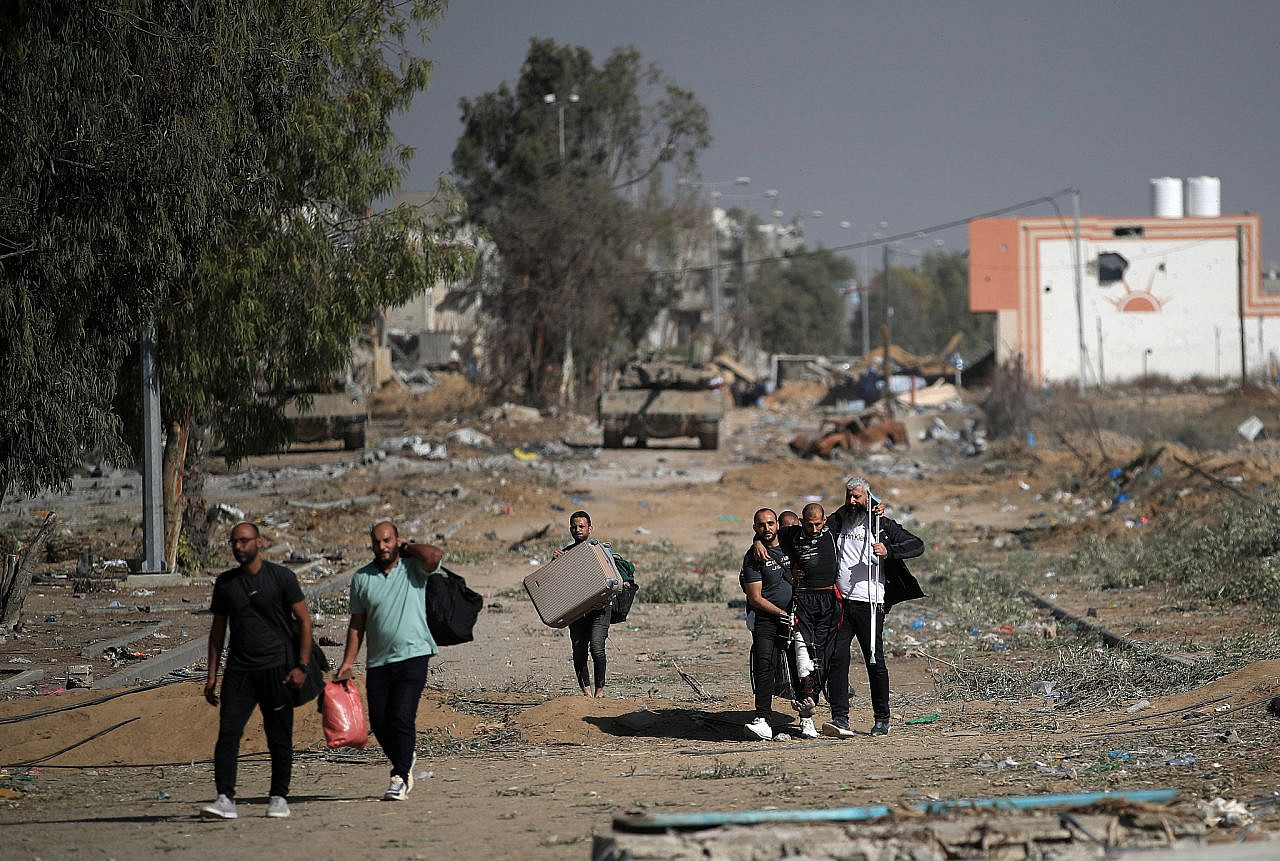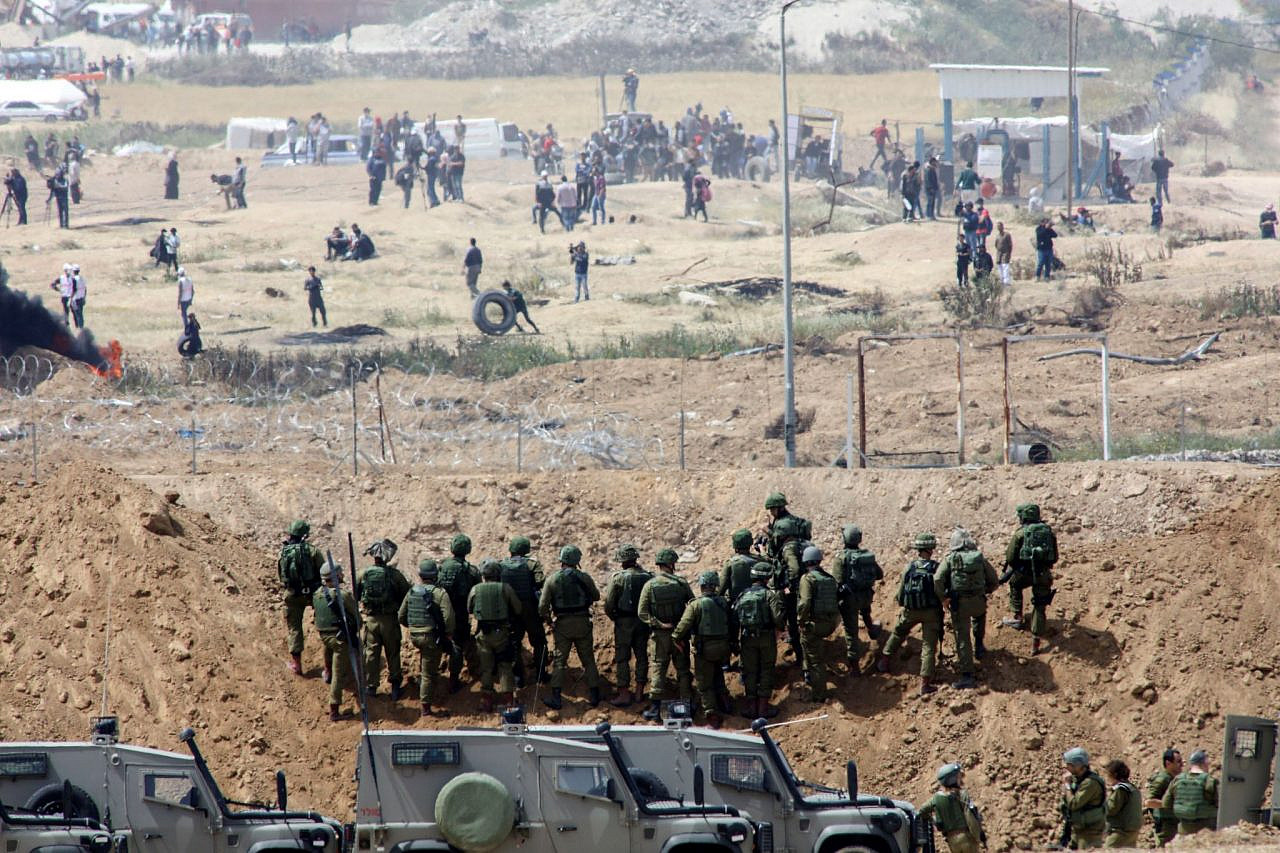More than seven months into the war, the Israeli military’s long-term plans for the Gaza Strip are becoming clearer. From satellite imagery and eyewitness testimonies, it appears that the army is destroying homes, bulldozing land, and erecting structures that will enable it to operate within Gaza for years to come.
Since the start of the war, the military has demolished buildings along the eastern edge of the Gaza Strip, part of what is widely believed to be a plan to establish a kilometer-wide “buffer zone” between populated areas in Gaza and Israel — the equivalent of 16 percent of Gaza’s territory — which Palestinians would be banned from entering. Doing so would permanently displace thousands of civilians and severely impact Gaza’s already-limited agricultural sector.
Yet this buffer zone is not the only way the Israeli military may permanently transform Gaza’s geography. Since October, the abandoned Netzarim checkpoint — which the Israeli military operated prior to its “disengagement” from Gaza in 2005 — has been expanded into a 6.5-kilometer-long road bisecting the strip. Satellite images now show the “Netzarim Corridor” stretching from Gaza’s eastern boundary with Israel all the way to the Mediterranean Sea, as well as extensive construction of housing units, communications towers, and other infrastructure. By building outposts along the Netzarim Corridor, the army will be able to control and restrict movement across Gaza and continue to carry out ground operations.
Such rampant destruction of private property and occupation of territory outside Israel’s recognized borders is a flagrant violation of international law, with immediate consequences for Gaza’s civilian population. In addition to the loss of their lands and homes, Palestinians who were displaced by the war to the south of the Strip are now physically blocked from even returning to the north.
Tasnim Ahal, a 21-year-old student from Gaza City, was displaced to Rafah in late March. “My father initially refused to leave Gaza City and move to the south, so we lived for nearly six months moving from one area in Gaza City to another,” she told +972. She and her sister ultimately decided to flee to Rafah, with the hope of staying alive to complete their academic programs and pursue a better future.
They tried to leave at a strategic moment. “The last time Al-Shifa Hospital was raided during the month of Ramadan, I said goodbye to my family, and my sister Sama and I went to walk to the south. I told my family that the army was busy storming Al-Shifa Hospital, so we wouldn’t run into tanks on our way. But we were wrong.”

Tasnim quickly encountered what she described as a “complete military base” at Netzarim, with Israeli tanks roaming through the area. “I saw soldiers in civilian clothing, walking around by the sea. It was clear that they were residing there and had built a base for themselves.” Sama, Tasnim’s 19-year-old sister, noted “dozens of soldiers in the area,” equipped with facial surveillance devices, “as if the area was completely occupied.”
Tasnim and Sama described being followed by a tank until they reached a group of Israeli soldiers. “The soldiers allowed us to pass … but they unleashed dogs on us, and we did not look back. We saw Gaza City for the last time as a pile of ashes and said goodbye, in the hope that we would return to it soon.”
‘We will not return to our homes if the army carries out its plan’
As the Israeli military widens the buffer zone separating Gaza from Israel, Palestinians are witnessing the destruction of their homes and villages. Khaled Taima is from the town of Khuza’a, which lies east of Khan Younis — and now within the expanded buffer zone. While Taima has not yet seen any construction activity, he noted to +972 that “the army blew up many of the buildings in Khuza’a and bulldozed a lot of land there as well,” razing entire residential blocks. Taima has repeatedly tried to return to Khuza’a, but each time, “the tanks fired at us and prevented us from reaching the area.”
This destruction appears to be consistent along Gaza’s entire eastern perimeter. Rami Obaid, a resident of the town of Beit Hanoun, in the northeast corner of the Strip, told +972 that he was worried about “the effects of the extensive bulldozing and destruction” in areas near the border fence, especially for those who had lost their homes and lands as a result of the widened buffer zone. “We will not return to our homes if the army carries out its plan,” he lamented.
Before October 7, Israel had long maintained a 300-meter buffer zone carved out of Gaza’s territory, and routinely shot and killed Palestinians who entered the area. Only a small number of farmers with approval from the military were allowed into the zone.
This was also the site of the 2018 Great March of Return, where Palestinians gathered every Friday for over a year to call for an end to Israel’s blockade on Gaza and the implementation of their right of return. Protesters were met with fierce violence: over the course of 18 months, Israeli snipers killed 223 Palestinians and injured over 8,000 with live ammunition, including medics and journalists.

Now, Israeli officials claim that massively expanding the buffer zone is necessary for Israelis to return to the towns surrounding the Gaza Strip, which were evacuated after the Hamas-led attacks on October 7. But it also seems to be a strategic move by Israel to strengthen its hand in future negotiations, according to Reham Owda, a political analyst in Gaza.
“On the day after the war, the international community will want to return to negotiating a two-state solution, and if the PA takes over Gaza, it will have to negotiate with Israel for its military to evacuate the buffer zone,” Owda explained. “These areas will have the same fate as those taken by Israel in the West Bank: the Palestinians will have to negotiate in order to get them back.”
Owda believes that the Israeli buffer zone may extend the entire length of Gaza, including the eastern area of the city of Rafah, where the military launched its incursion at the beginning of May. Sami Zoroub, a 32-year-old from the Al-Shu’ara neighborhood of Rafah, is one of the hundreds of thousands of Palestinians who were displaced as Israeli tanks moved into the city. While the Israeli army issued evacuation notices to the residents of Al-Shu’ara, Zoroub and his family initially remained in their home, reassured by “the statements from American officials that said that the operation was limited to the east of the city.” Yet continuous bombing in eastern Rafah kept them up at night, and they soon moved to a relative’s home in the city center, only to be followed by approaching tanks.
Most read on +972
“Now we have moved to the west of Rafah, to the Al-Mawasi area,” Zoroub told +972. “We did not expect the army to penetrate the city of Rafah by land, in spite of the warnings of countries around the world.”
Throughout Gaza, the Israeli military’s destruction of homes and seizure of land is an ominous sign for the future of the Strip. Obaid’s wife, who was displaced to a camp in Deir Al-Balah, told him that “watchtowers and cameras were deployed all along the [coastal] road, and … quadcopters and reconnaissance planes are monitoring the area and preventing citizens from returning to the north.” As Israel expands and cements this military architecture, Obaid observed, “it’s as if Gaza is entirely under their control.”

![An Israeli tank seen near the Gaza border fence, March 26, 2024. [Chaim Goldberg/Flash90] An Israeli tank seen near the Gaza border fence, March 26, 2024. [Chaim Goldberg/Flash90]](https://static.972mag.com/www/uploads/2024/05/F240326CG56-1200x802.jpg)


